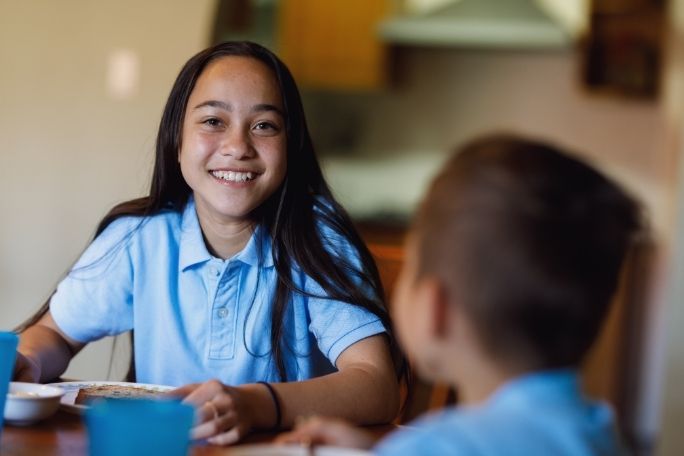Lesson summary
This lesson forms part of a Design Thinking Unit in which students identify issues relating to recycling, build an understanding of the impact that not recycling can have in their own community, work to find and prototype a solution, then take action in their community that addresses the issues they have identified. In this lesson, students reflect on the Design Thinking process, their own personal development and the success of their action. While this lesson forms part of a specific recycling-based unit, it can be implemented to aid reflection on any Design Thinking project students have undertaken.
Learning intentions:
Students will...
- be able to reflect critically on what they have learned throughout the Design Thinking project
Success Criteria:
Students can...
- include details about what they learned throughout the stages of the Design Thinking project in a presentation
- describe the impact that their project has had upon the issue of recycling
- identify the success they have achieved
- identify areas where they can improve and grow
Lesson guides and printables
Lesson details
Curriculum mapping
Australian curriculum content descriptions:
Year 5 English:
- Plan, rehearse and deliver presentations for defined audiences and purposes incorporating accurate and sequenced content and multimodal elements (ACELY1700).
- Identify and explain characteristic text structures and language features used in imaginative, informative and persuasive texts to meet the purpose of the text (ACELY1701).
- Plan, draft and publish imaginative, informative and persuasive print and multimodal texts, choosing text structures, language features, images and sound appropriate to purpose and audience (ACELY1704).
- Use a range of software including word processing programs with fluency to construct, edit and publish written text, and select, edit and place visual, print and audio elements (ACELY1707).
Year 6 English:
- Plan, rehearse and deliver presentations, selecting and sequencing appropriate content and multimodal elements for defined audiences and purposes, making appropriate choices for modality and emphasis (ACELY1710).
- Plan, draft and publish imaginative, informative and persuasive texts, choosing and experimenting with text structures, language features, images and digital resources appropriate to purpose and audience (ACELY1714).
- Use a range of software, including word processing programs, learning new functions as required to create texts (ACELY1717).
Year 5 and 6 Design & Technologies:
- Negotiate criteria for success that include sustainability to evaluate design ideas, processes and solutions (ACTDEP027).
General capabilities: Literacy.
Cross-curriculum priority: Sustainability OI.6, OI.8.
Relevant parts of the Year 5 English Achievement Standards: Students create imaginative, informative and persuasive texts for different purposes and audiences. They make presentations which include multimodal elements for defined purposes.
Relevant parts of the Year 6 English Achievement Standards: Students create detailed texts elaborating on key ideas for a range of purposes and audiences. They make presentations and contribute actively to class and group discussions, using a variety of strategies for effect.
Relevant parts of the Year 5 and 6 Design & Technologies Achievement Standards: Students plan and document processes and resources and safely produce designed solutions for each of the prescribed technologies contexts. They negotiate criteria for success, including sustainability considerations, and use these to judge the suitability of their ideas, solutions and processes. Students use ethical, social and technical protocols when collaborating, and creating and communicating ideas, information and solutions face-to-face and online.
Unit of work: Visy Education – Using Design Thinking to Solve Problems – Years 5 & 6.
Time required: 120 mins.
Level of teacher scaffolding: Medium – tasks within the Design Thinking Unit are designed to encourage students to work independently and in groups to develop their own ideas and actions. The teacher will need to observe and monitor groups, conferencing when suitable and providing support to interpret and present data and plan and implement actions.
Resources required
- Design Thinking Workbook (one per student, retained from previous lessons)
- Digital devices capable of accessing word processing and presentation software (one per student)
- Additional resources required to develop showcases (determined at teacher discretion based on options provided to students)
- If students will be developing podcasts or videos, audio-visual equipment will be required
- Students making posters will require large printers or poster paper
Skills
- Communication
- Community engagement
- Creativity
- Leadership
- Initiative
- Social skills
Additional info
This lesson has been developed in partnership with Visy. For over 70 years Visy has been committed to finding sustainable solutions for Australia and New Zealand’s recyclables and helping to reduce local landfills. Visy collects, receives and sorts paper, cardboard, glass, plastics, steel and aluminium from households, businesses and schools with the purpose of reusing these products in the re-manufacture of new packaging products.


Welcome back!
Don't have an account yet?
Log in with:
By signing up to Cool.org you consent and agree to Cool's privacy policy to
store, manage and process your personal information. To read more, please see
our privacy policy here(Opens in new tab).
Create your free Cool.org account.
Many of our resources are free, with an option to upgrade to Cool+ for premium content.
Already have an account?
Sign up with:
By signing up to Cool.org you consent and agree to Cool's privacy policy to
store, manage and process your personal information. To read more, please see
our privacy policy here(Opens in new tab).